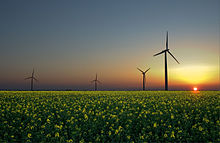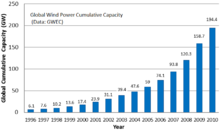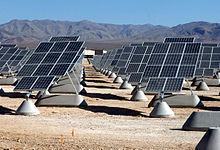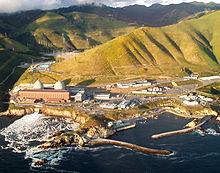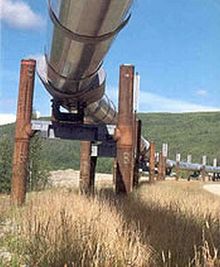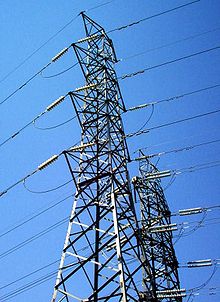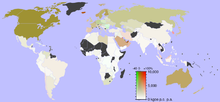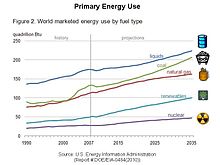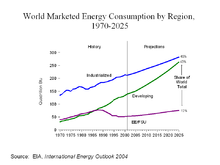- Energy development
-
Energy development is the effort to provide sufficient primary energy sources and secondary energy forms for supply, cost, impact on air pollution and water pollution, mitigation of climate change with renewable energy.
Technologically advanced societies have become increasingly dependent on external energy sources for transportation, the production of many manufactured goods, and the delivery of energy services. This energy allows people who can afford the cost to live under otherwise unfavorable climatic conditions through the use of heating, ventilation, and/or air conditioning. Level of use of external energy sources differs across societies, as do the climate, convenience, levels of traffic congestion, pollution and availability of domestic energy sources.
Contents
Renewable sources
Renewable energy is energy which comes from natural resources such as sunlight, wind, rain, tides, and geothermal heat, which are renewable (naturally replenished.) Renewable energy is an alternative to fossil fuels and nuclear power, and was commonly called alternative energy in the 1970s and 1980s. In 2008, about 19% of global final energy consumption came from renewables, with 13% coming from traditional biomass, which is mainly used for heating, and 3.2% from hydroelectricity.[1] New renewables (small hydro, modern biomass, wind, solar, geothermal, and biofuels) accounted for another 2.7% and are growing very rapidly.[1] The share of renewables in electricity generation is around 18%, with 15% of global electricity coming from hydroelectricity and 3% from new renewables.[1][2]
Wind power is growing at the rate of 30% annually, with a worldwide installed capacity of 158 gigawatts (GW) in 2009,[3][4] and is widely used in Europe, Asia, and the United States.[5] At the end of 2009, cumulative global photovoltaic (PV) installations surpassed 21 GW[6][7][8] and PV power stations are popular in Germany and Spain.[9] Solar thermal power stations operate in the USA and Spain, and the largest of these is the 354 megawatt (MW) SEGS power plant in the Mojave Desert.[10] The world's largest geothermal power installation is The Geysers in California, with a rated capacity of 750 MW. Brazil has one of the largest renewable energy programs in the world, involving production of ethanol fuel from sugar cane, and ethanol now provides 18% of the country's automotive fuel.[11] Ethanol fuel is also widely available in the USA.
Climate change concerns, coupled with high oil prices, peak oil, and increasing government support, are driving increasing renewable energy legislation, incentives and commercialization.[12] New government spending, regulation and policies helped the industry weather the global financial crisis better than many other sectors.[13] Scientists have advanced a plan to power 100% of the world's energy with wind, hydroelectric, and solar power by the year 2030,[14][15] recommending renewable energy subsidies and a price on carbon reflecting its cost for flood and related expenses.
While many renewable energy projects are large-scale, renewable technologies are also suited to rural and remote areas, where energy is often crucial in human development.[16] Globally, an estimated 3 million households get power from small solar PV systems. Micro-hydro systems configured into village-scale or county-scale mini-grids serve many areas.[17] More than 30 million rural households get lighting and cooking from biogas made in household-scale digesters. Biomass cookstoves are used by 160 million households.[17]
Wind
Wind power harnesses the power of the wind to propel the blades of wind turbines. These turbines cause the rotation of magnets, which creates electricity. Wind towers are usually built together on wind farms. Wind power is growing at the rate of 30% annually, with a worldwide installed capacity of 158 gigawatts (GW) in 2009,[3][4] and is widely used in Europe, Asia, and the United States.[5]
At the end of 2010, worldwide nameplate capacity of wind-powered generators was 197 gigawatts (GW).[19] Energy production was 430 TWh, which is about 2.5% of worldwide electricity usage.[19][20] Several countries have achieved relatively high levels of wind power penetration, such as 21% of stationary electricity production in Denmark,[19] 18% in Portugal,[19] 16% in Spain,[19] 14% in Ireland[21] and 9% in Germany in 2010.[19][22] As of 2011, 83 countries around the world are using wind power on a commercial basis.[22]
Hydroelectric
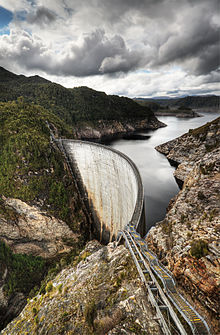 The Gordon Dam in Tasmania is a large conventional dammed-hydro facility, with an installed capacity of up to 430 MW.
The Gordon Dam in Tasmania is a large conventional dammed-hydro facility, with an installed capacity of up to 430 MW.
In hydro energy, the gravitational descent of a river is compressed from a long run to a single location with a dam or a flume. This creates a location where concentrated pressure and flow can be used to turn turbines or water wheels, which drive a mechanical mill or an electric generator.[23]
In some cases with hydroelectric dams, there are unexpected results. One study shows that a hydroelectric dam in the Amazon has 3.6 times larger greenhouse effect per kW•h than electricity production from oil, due to large scale emission of methane from decaying organic material[24], though this is most significant as river valleys are initially flooded, and are of much less consequence for more boreal dams.[25] This effect applies in particular to dams created by simply flooding a large area, without first clearing it of vegetation. There are however investigations into underwater turbines that do not require a dam. And pumped-storage hydroelectricity can use water reservoirs at different altitudes to store wind and solar power.
Solar
Solar power involves using solar cells to convert sunlight into electricity, using sunlight hitting solar thermal panels to convert sunlight to heat water or air, using sunlight hitting a parabolic mirror to heat water (producing steam), or using sunlight entering windows for passive solar heating of a building. It would be advantageous to place solar panels in the regions of highest solar radiation.[26]
At the end of 2009, cumulative global photovoltaic (PV) installations surpassed 21 GW[6][7][8] and PV power stations are popular in Germany and Spain.[9] Solar thermal power stations operate in the USA and Spain, and the largest of these is the 354 megawatt (MW) SEGS power plant in the Mojave Desert.[10]
China is increasing worldwide silicon wafer capacity for photovoltaics to 2,000 metric tons by July 2008, and over 6,000 metric tons by the end of 2010.[27] Significant international investment capital is flowing into China to support this opportunity. China is building large subsidized off-the-grid solar-powered cities in Huangbaiyu and Dongtan Eco City. Much of the design was done by Americans such as William McDonough.[28]
Agricultural biomass
Biomass production involves using garbage or other renewable resources such as corn or other vegetation to generate electricity. When garbage decomposes, the methane produced is captured in pipes and later burned to produce electricity. Vegetation and wood can be burned directly to generate energy, like fossil fuels, or processed to form alcohols. Brazil has one of the largest renewable energy programs in the world, involving production of ethanol fuel from sugar cane, and ethanol now provides 18% of the country's automotive fuel.[11] Ethanol fuel is also widely available in the USA.
Vegetable oil is generated from sunlight, H2O, and CO2 by plants. It is safer to use and store than gasoline or diesel as it has a higher flash point. Straight vegetable oil works in diesel engines if it is heated first. Vegetable oil can also be transesterified to make biodiesel, which burns like normal diesel.
Geothermal
Geothermal energy harnesses the heat energy present underneath the Earth. Two wells are drilled. One well injects water into the ground to provide water. The hot rocks heat the water to produce steam. The steam that shoots back up the other hole(s) is purified and is used to drive turbines, which power electric generators. When the water temperature is below the boiling point of water a binary system is used. A low boiling point liquid is used to drive a turbine and generator in a closed system similar to a refrigeration unit running in reverse. There are also natural sources of geothermal energy: some can come from volcanoes, geysers, hot springs, and steam vents.[29] The world's largest geothermal power installation is The Geysers in California, with a rated capacity of 750 MW.
Tidal
Tidal power can be extracted from Moon-gravity-powered tides by locating a water turbine in a tidal current, or by building impoundment pond dams that admit-or-release water through a turbine. The turbine can turn an electrical generator, or a gas compressor, that can then store energy until needed. Coastal tides are a source of clean, free, renewable, and sustainable energy.[30]
Fossil fuels
Fossil fuels sources burn coal or hydrocarbon fuels, which are the remains of the decomposition of plants and animals. There are three main types of fossil fuels: coal, petroleum, and natural gas. Another fossil fuel, liquefied petroleum gas (LPG), is principally derived from the production of natural gas. Heat from burning fossil fuel is used either directly for space heating and process heating, or converted to mechanical energy for vehicles, industrial processes, or electrical power generation.
Greenhouse gas emissions result from fossil fuel-based electricity generation. Currently governments subsidize fossil fuels by an estimated $500 billion a year.[31]
Nuclear
Fission
Nuclear power stations use nuclear fission to generate energy by the reaction of uranium-235 inside a nuclear reactor. The reactor uses uranium rods, the atoms of which are split in the process of fission, releasing a large amount of energy. The process continues as a chain reaction with other nuclei. The energy heats water to create steam, which spins a turbine generator, producing electricity.
Depending on the type of fission fuel considered, estimates for existing supply at known usage rates varies from several decades for the currently popular Uranium-235 to thousands of years for uranium-238. At the present rate of use, there are (as of 2007) about 70 years left of known uranium-235 reserves economically recoverable at a uranium price of US$ 130/kg.[32] The nuclear industry argue that the cost of fuel is a minor cost factor for fission power, more expensive, more difficult to extract sources of uranium could be used in the future, such as lower-grade ores, and if prices increased enough, from sources such as granite and seawater.[32] Increasing the price of uranium would have little effect on the overall cost of nuclear power; a doubling in the cost of natural uranium would increase the total cost of nuclear power by 5 percent. On the other hand, if the price of natural gas was doubled, the cost of gas-fired power would increase by about 60 percent.[33]
Opponents on the other hand argue that the correlation between price and production is not linear, but as the ores' concentration becomes smaller, the difficulty (energy and resource consumption are increasing, while the yields are decreasing) of extraction rises very fast, and that the assertion that a higher price will yield more uranium is overly optimistic; for example a rough estimate predicts that the extraction of uranium from granite will consume at least 70 times more energy than what it will produce in a reactor. As many as eleven countries have depleted their uranium resources, and only Canada has mines left that produce better than 1% concentration ore.[34] Seawater seems to be equally dubious as a source.[35]
Nuclear meltdowns and other reactor accidents, such as the Fukushima I nuclear accident (2011), Three Mile Island accident (1979) and the Chernobyl disaster (1986), have caused much public concern. Research is being done to lessen the known problems of current reactor technology by developing automated and passively safe reactors. Historically, however, coal and hydropower power generation have both been the cause of more deaths per energy unit produced than nuclear power generation.[36][37]
Nuclear proliferation is the spread of nuclear technology which may happen from nation to nation or through other black market channels, including nuclear power plants and related technology including nuclear weapons.
The long-term radioactive waste storage problems of nuclear power have not been solved. Several countries have considered using underground repositories. Nuclear waste takes up little space compared to wastes from the chemical industry which remain toxic indefinitely.[38] Spent fuel rods are now stored in concrete casks close to the nuclear reactors.[39] The amounts of waste could be reduced in several ways. Both nuclear reprocessing and breeder reactors could reduce the amounts of waste. Subcritical reactors or fusion reactors could greatly reduce the time the waste has to be stored.[40] Subcritical reactors may also be able to do the same to already existing waste. The only long-term way of dealing with waste today is by geological storage.
At present, nuclear energy is in decline, according to a 2007 World Nuclear Industry Status Report presented by the Greens/EFA group in the European Parliament. The report outlines that the proportion of nuclear energy in power production has decreased in 21 out of 31 countries, with five fewer functioning nuclear reactors than five years ago. There are currently 32 nuclear power plants under construction or in the pipeline, 20 fewer than at the end of the 1990s.[41][42]
Thorium can be used as fuel in a nuclear reactor. A thorium fuel cycle offers several potential advantages over a uranium fuel cycle including much greater abundance on Earth, superior physical and nuclear properties of the fuel, enhanced proliferation resistance, and reduced nuclear waste production. Nobel laureate Carlo Rubbia at CERN (European Organization for Nuclear Research), has worked on developing the use of thorium as an alternative to uranium in reactors. Rubbia states that a tonne of thorium can produce as much energy as 200 tonnes of uranium, or 3,500,000 tonnes of coal.[43] One of the early pioneers of the technology was U.S. physicist Alvin Weinberg at Oak Ridge National Laboratory in Tennessee, who helped develop a working nuclear plant using liquid fuel in the 1960s.
Fusion
Fusion power could solve many of the problems of fission power (the technology mentioned above) but, despite research having started in the 1950s, no commercial fusion reactor is expected before 2050.[44] Many technical problems remain unsolved. Proposed fusion reactors commonly use deuterium, an isotope of hydrogen, as fuel and in most current designs also lithium. Assuming a fusion energy output equal to the current global output and that this does not increase in the future, then the known current lithium reserves would last 3000 years, lithium from sea water would last 60 million years, and a more complicated fusion process using only deuterium from sea water would have fuel for 150 billion years.[45]
Cost by source
The following chart does not include the external, weather-related costs of using fossil fuels.
Large energy subsidies are present in many countries (Barker et al., 2001:567-568).[46] Currently governments subsidize fossil fuels by $557 billion per year.[31][47] Economic theory indicates that the optimal policy would be to remove coal mining and burning subsidies and replace them with optimal taxes. Global studies indicate that even without introducing taxes, subsidy and trade barrier removal at a sectoral level would improve efficiency and reduce environmental damage. Removal of these subsidies would substantially reduce GHG emissions and stimulate economic growth.
Increased energy efficiency
Energy efficiency is increasing by about 2% a year[citation needed], and absorbs most of the requirements for energy development. New technology makes better use of already available energy through improved efficiency, such as more efficient fluorescent lamps, engines, and insulation. Using heat exchangers, it is possible to recover some of the energy in waste warm water and air, for example to preheat incoming fresh water. Hydrocarbon fuel production from pyrolysis could also be in this category, allowing recovery of some of the energy in hydrocarbon waste. Already existing power plants often can and usually are made more efficient with minor modifications due to new technology. New power plants may become more efficient with technology like cogeneration. New designs for buildings may incorporate techniques like passive solar. Light-emitting diodes are gradually replacing the remaining uses of light bulbs. Note that none of these methods allows perpetual motion, as some energy is always lost to heat.
Mass transportation increases energy efficiency compared to widespread conventional automobile use while air travel is regarded as inefficient. Conventional combustion engine automobiles have continually improved their efficiency and may continue to do so in the future, for example by reducing weight with new materials. Hybrid vehicles can save energy by allowing the engine to run more efficiently, regaining energy from braking, turning off the motor when idling in traffic, etc. More efficient ceramic or diesel engines can improve mileage. Electric vehicles such as Maglev, trolleybuses, and PHEVs are more efficient during use (but maybe not if doing a life cycle analysis) than similar current combustion based vehicles, reducing their energy consumption during use by 1/2 to 1/4. Microcars or motorcycles may replace automobiles carrying only one or two people. Transportation efficiency may also be improved by in other ways, see automated highway system.
Electricity distribution may change in the future. New small scale energy sources may be placed closer to the consumers so that less energy is lost during electricity distribution. New technology like superconductivity or improved power factor correction may also decrease the energy lost. Distributed generation permits electricity "consumers," who are generating electricity for their own needs, to send their surplus electrical power back into the power grid.
Transmission
While new sources of energy are only rarely discovered or made possible by new technology, distribution technology continually evolves.[48] The use of fuel cells in cars, for example, is an anticipated delivery technology.[citation needed] This section presents some of the more common delivery technologies that have been important to historic energy development. They all rely in some way on the energy sources listed in the previous section.
Water
Fossil fuels
Shipping is a flexible delivery technology that is used in the whole range of energy development regimes from primitive to highly advanced. Currently, coal, petroleum and their derivatives are delivered by shipping via boat, rail, or road. Petroleum and natural gas may also be delivered via pipeline and coal via a Slurry pipeline. Refined hydrocarbon fuels such as gasoline and LPG may also be delivered via aircraft. Natural gas pipelines must maintain a certain minimum pressure to function correctly. Ethanol's corrosive properties make it harder to build ethanol pipelines. The higher costs of ethanol transportation and storage are often prohibitive.[49]
Electricity
Electricity grids are the networks used to transmit and distribute power from production source to end user, when the two may be hundreds of kilometres away. Sources include electrical generation plants such as a nuclear reactor, coal burning power plant, etc. A combination of sub-stations, transformers, towers, cables, and piping are used to maintain a constant flow of electricity. Grids may suffer from transient blackouts and brownouts, often due to weather damage. During certain extreme space weather events solar wind can interfere with transmissions. Grids also have a predefined carrying capacity or load that cannot safely be exceeded. When power requirements exceed what's available, failures are inevitable. To prevent problems, power is then rationed.
Industrialised countries such as Canada, the US, and Australia are among the highest per capita consumers of electricity in the world, which is possible thanks to a widespread electrical distribution network. The US grid is one of the most advanced, although infrastructure maintenance is becoming a problem. CurrentEnergy provides a realtime overview of the electricity supply and demand for California, Texas, and the Northeast of the US. African countries with small scale electrical grids have a correspondingly low annual per capita usage of electricity. One of the most powerful power grids in the world supplies power to the state of Queensland, Australia.
Storage
Methods of energy storage have been developed, which transform electrical energy into forms of potential energy. A method of energy storage may be chosen on the basis of stability, ease of transport, ease of energy release, or ease of converting free energy from the natural form to the stable form.
Chemical
Some natural forms of energy are found in stable chemical compounds such as fossil fuels. Most systems of chemical energy storage result from biological activity, which store energy in chemical bonds. Man-made forms of chemical energy storage include hydrogen fuel, synthetic hydrocarbon fuel, batteries and explosives such as cordite and dynamite.
Gravitational and hydroelectric
Dams can be used to store energy, by using pumped-storage hydroelectricity, excess energy to pump water into the reservoir. When electrical energy is required, the process is reversed. The water then turns a turbine, generating electricity. Hydroelectric power is currently an important part of the world's energy supply, generating one-fifth of the world's electricity.[50]
Thermal
There are several technologies to store heat. Thermal energy from the sun, for example, can be stored in a reservoir or in the ground for daily or seasonal use. Thermal energy for cooling can be stored in ice.[51] Many thermal power plants are set up near coal or oil fields. The thermal power plant is used since fuel is burnt to produce heat energy, which is converted into electrical energy .[51]
Mechanical pressure
Energy may also be stored in pressurized gases or alternatively in a vacuum. Compressed air, for example, may be used to operate vehicles and power tools. Large-scale compressed air energy storage facilities are used to smooth out demands on electricity generation by providing energy during peak hours and storing energy during off-peak hours. Such systems save on expensive generating capacity since it only needs to meet average consumption rather than peak consumption.[52]
Electrical capacitance
Electrical energy may be stored in capacitors. Capacitors are often used to produce high intensity releases of energy (such as a camera's flash).
Hydrogen
Hydrogen can be manufactured at roughly 77 percent thermal efficiency by the method of steam reforming of natural gas.[53] When manufactured by this method it is a derivative fuel like gasoline; when produced by electrolysis of water, it is a form of chemical energy storage as are storage batteries, though hydrogen is the more versatile storage mode since there are two options for its conversion to useful work: (1) a fuel cell can convert the chemicals hydrogen and oxygen into water, and in the process, produce electricity, or (2) hydrogen can be burned (less efficiently than in a fuel cell) in an internal combustion engine.
Vehicles
Fossil fuels
Petroleum, coal and natural gas are used to power most transportation and buildings.
Batteries
- Main articles: battery, battery electric vehicle
Batteries are used to store energy in a chemical form. As an alternative energy, batteries can be used to store energy in battery electric vehicles. Battery electric vehicles can be charged from the grid when the vehicle is not in use. Because the energy is derived from electricity, battery electric vehicles make it possible to use other forms of alternative energy such as wind, solar, geothermal, nuclear, or hydroelectric.
Compressed air
- Main articles: Compressed air vehicle, Air car
The Indian company, Tata, is planning to release a compressed air powered car in 2008.
Sustainability
The environmental movement emphasizes sustainability of energy use and development. Renewable energy is sustainable in its production; the available supply will not be diminished for the foreseeable future - millions or billions of years. "Sustainability" also refers to the ability of the environment to cope with waste products, especially air pollution. Sources which have no direct waste products (such as wind, solar, and hydropower) are seen as ideal in this regard.
Fossil fuels such as petroleum, coal, and natural gas are not renewable. For example, the timing of worldwide peak oil production is being actively debated but it has already happened in some countries. Fossil fuels also make up the bulk of the world's current primary energy sources. With global demand for energy growing, the need to adopt alternative energy sources is also growing. Fossil fuels are also a major source of greenhouse gas emissions, leading to concerns about global warming if consumption is not reduced.
Energy conservation is an alternative or complementary process to energy development. It reduces the demand for energy by using it more efficiently.
Resilience
Some observers contend that the much talked about idea of “energy independence” is an unrealistic and opaque concept. They offer “energy resilience” as a more sensible goal and more aligned with economic, security and energy realities. The notion of resilience in energy was detailed in the 1982 book Brittle Power: Energy Strategy for National Security.[54] The authors argued that simply switching to domestic energy would be no more secure inherently because the true weakness is the interdependent and vulnerable energy infrastructure of the United States. Key aspects such as gas lines and the electrical power grid are centralized and easily susceptible to major disruption. They conclude that a “resilient energy supply” is necessary for both national security and the environment. They recommend a focus on energy efficiency and renewable energy that is more decentralized.[55]
More recently former Intel Corporation Chairman and CEO Andrew Grove has touted energy resilience, arguing that complete independence is infeasible given the global market for energy.[56] He describes energy resilience as the ability to adjust to interruptions in the supply of energy. To this end he suggests the U.S. make greater use of electricity.[57] Electricity can be produced from a variety of sources. A diverse energy supply will be less impacted by the disruption in supply of any one source. He reasons that another feature of electrification is that electricity is “sticky” – meaning the electricity produced in the U.S. is more likely to stay there because it cannot be transported overseas. According to Grove, a key aspect of advancing electrification and energy resilience will be converting the U.S. automotive fleet from gasoline-powered to electric-powered. This, in turn, will require the modernization and expansion of the electrical power grid. As organizations such as the Reform Institute have pointed out, advancements associated with the developing smart grid would facilitate the ability of the grid to absorb vehicles en masse connecting to it to charge their batteries.[58]
Future
Extrapolations from current knowledge to the future offer a choice of energy futures.[59] Some predictions parallel the Malthusian catastrophe hypothesis. Numerous are complex models based scenarios as pioneered by Limits to Growth. Modeling approaches offer ways to analyze diverse strategies, and hopefully find a road to rapid and sustainable development of humanity. Short term energy crises are also a concern of energy development. Some extrapolations lack plausibility, particularly when they predict a continual increase in oil consumption.
Energy production usually requires an energy investment. Drilling for oil or building a wind power plant requires energy. The fossil fuel resources (see above) that are left are often increasingly difficult to extract and convert. They may thus require increasingly higher energy investments. If the investment is greater than the energy produced, then the fossil resource is no longer an energy source. This means that a large part of the fossil fuel resources and especially the non-conventional ones cannot be used for energy production today. Such resources may still be exploited economically in order to produce raw materials for plastics, fertilizers or even transportation fuel but now more energy is consumed than produced. (They then become similar to ordinary mining reserves, economically recoverable but not net positive energy sources.) New technology may ameliorate this problem if it can lower the energy investment required to extract and convert the resources, although ultimately basic physics sets limits that cannot be exceeded.
Between 1950 and 1984, as the Green Revolution transformed agriculture around the globe, world grain production increased by 250%. The energy for the Green Revolution was provided by fossil fuels in the form of fertilizers (natural gas), pesticides (oil), and hydrocarbon fueled irrigation.[60] The peaking of world hydrocarbon production (peak oil) may lead to significant changes, and require sustainable methods of production.[61]
See also
- Energy planning
- Energy policy
- Energy policy of the United States
- Environmental concerns with electricity generation
- Nuclear energy policy
- Proposed future transport
- Renewable energy commercialization
- Relative cost of electricity generated by different sources
- World energy resources and consumption
References
- ^ a b c REN21 (2010). Renewables 2010 Global Status Report p. 15-16.
- ^ REN21 (2008). Global Status Report 2007 REN21 Secretariat, 51 pages.
- ^ a b Lars Kroldrup. Gains in Global Wind Capacity Reported Green Inc., February 15, 2010.
- ^ a b REN21 (2009). Renewables Global Status Report: 2009 Update p. 9.
- ^ a b Global wind energy markets continue to boom – 2006 another record year (PDF).
- ^ a b James Russell. Record Growth in Photovoltaic Capacity and Momentum Builds for Concentrating Solar Power Vital Signs, June 03, 2010.
- ^ a b REN21 (2009). Renewables Global Status Report: 2009 Update p. 12.
- ^ a b REN21 (2009). Renewables Global Status Report: 2009 Update p. 15.
- ^ a b World's largest photovoltaic power plants
- ^ a b Solar Trough Power Plants (PDF).
- ^ a b America and Brazil Intersect on Ethanol
- ^ United Nations Environment Programme Global Trends in Sustainable Energy Investment 2007: Analysis of Trends and Issues in the Financing of Renewable Energy and Energy Efficiency in OECD and Developing Countries (PDF), p. 3.
- ^ Clean Edge (2009). Clean Energy Trends 2009 pp. 1-4.
- ^ Jacobson, M.Z. and Delucchi, M.A. (November 2009) "A Plan to Power 100 Percent of the Planet with Renewables" (originally published as "A Path to Sustainable Energy by 2030") Scientific American 301(5):58-65
- ^ Jacobson, M.Z. (2009) "Review of solutions to global warming, air pollution, and energy security" Energy and Environmental Science 2:148-73 doi 10.1039/b809990c (review.)
- ^ World Energy Assessment (2001). Renewable energy technologies, p. 221.
- ^ a b REN21 (2010). Renewables 2010 Global Status Report p. 12.
- ^ GWEC, Global Wind Report Annual Market Update
- ^ a b c d e f "World Wind Energy Report 2010" (PDF). Report. World Wind Energy Association. February 2011. http://www.wwindea.org/home/images/stories/pdfs/worldwindenergyreport2010_s.pdf. Retrieved 8-August-2011.
- ^ "Wind Power Increase in 2008 Exceeds 10-year Average Growth Rate". Worldwatch.org. http://www.worldwatch.org/node/6102?emc=el&m=239273&l=5&v=ca5d0bd2df. Retrieved 2010-08-29.
- ^ "Renewables". eirgrid.com. http://www.eirgrid.com/renewables/. Retrieved 22 November 2010.
- ^ a b REN21 (2011). "Renewables 2011: Global Status Report". p. 11. http://www.ren21.net/Portals/97/documents/GSR/GSR2011_Master18.pdf.
- ^ http://www.worldbookonline.com/digitallibraries/livinggreen/article?id=ar836804&st=hydroelectric
- ^ Graham-Rowe, Duncan (2005-02-24). "Hydroelectric power's dirty secret revealed". New Scientist. http://www.newscientist.com/article.ns?id=dn7046.
- ^ Tremblay, Alain; Varfalvy, Louis; Roehm, Charlotte; Garneau, Michelle (2004). The issue of greenhouse gases from hydroelectric reservoirs: from boreal to tropical regions. pp. 11. http://www.un.org/esa/sustdev/sdissues/energy/op/hydro_tremblaypaper.pdf.
- ^ http://www.worldbookonline.com/digitallibraries/livinggreen/article?id=ar836713&st=solar+power
- ^ "Suntech Announces Analyst and Investor Day Highlights". Suntech Power. 2007-12-11. http://www.suntech-power.com/News/tabid/99/Default.aspx?id=303&Module=597. Retrieved 2008-01-19.[dead link]
- ^ http://galenet.galegroup.com/servlet/SciRC?locID=cobb90289&bi=KE&bt=William+McDonough&c=2&t=2&ste=22&docNum=A182810130&st=b&tc=30&tf=0
- ^ Dovey, Karen. Energy Alternatives. Farmington Hills, Minassota: Lucent Books, 1962
- ^ http://galenet.galegroup.com/servlet/SciRC?locID=cobb90289&bi=KE&bt=tidal+power&c=1&t=1&ste=21&docNum=CV2644151381&st=b&tc=31&tf=0
- ^ a b ScienceDaily.com (Apr. 22, 2010) "Fossil-Fuel Subsidies Hurting Global Environment, Security, Study Finds"
- ^ a b "Supply of Uranium". World Nuclear Association. March 2007. http://www.world-nuclear.org/info/inf75.html. Retrieved 2008-01-18.
- ^ "The Economics of Nuclear Power". World Nuclear Association. June 2007. http://www.world-nuclear.org/info/inf02.html. Retrieved 2008-01-18.
- ^ Uranium Resources and Nuclear Energy
- ^ Jan Willem Storm van Leeuwen; Philip Smith (2005-07-30). "Nuclear Energy: the Energy Balance" (PDF). http://www.stormsmith.nl/report20050803/Chap_2.pdf. Retrieved 2008-01-18.
- ^ Gary Crawley. "Risks vs. Benefits in Energy Production" (PDF). Science Foundation Ireland. http://ee.ucd.ie/erc/events/nuclear/Crawley.pdf. Retrieved 2008-01-18.
- ^ Brendan Nicholson (2006-06-05). "Nuclear power 'cheaper, safer' than coal and gas". The Age. http://www.theage.com.au/news/national/nuclear-power-cheaper-safer-than-coal-and-gas/2006/06/04/1149359609052.html. Retrieved 2008-01-18.
- ^ "Waste Management in the Nuclear Fuel Cycle". World Nuclear Association. April 2007. http://www.world-nuclear.org/info/inf04.html. Retrieved 2008-01-18.
- ^ Peter Schwartz; Spencer Reiss (February 2005). "Nuclear Now!". Wired. http://www.wired.com/wired/archive/13.02/nuclear.html. Retrieved 2008-01-18.
- ^ "Accelerator-driven Nuclear Energy". World Nuclear Association. August 2003. http://www.world-nuclear.org/info/inf35.html. Retrieved 2008-01-18.
- ^ The Greens | European Free Alliance in the European Parliament - – Nuclear energy
- ^ http://www.greens-efa.org/cms/topics/dokbin/206/206749.the_world_nuclear_industry_status_report@en.pdf
- ^ "Obama could kill fossil fuels overnight with a nuclear dash for thorium", Evans-Pritchard, Ambrose. The Telegraph, U.K. August 29, 2010
- ^ "What is ITER?". ITER International Fusion Energy Organization. Archived from the original on 2007-12-18. http://web.archive.org/web/20071218134708/http://www.iter.org/index.htm. Retrieved 2008-01-18.
- ^ J. Ongena; G. Van Oost. "Energy for Future Centuries: Will fusion be an inexhaustible, safe and clean energy source?" (PDF). http://www.fusie-energie.nl/artikelen/ongena.pdf. Retrieved 2008-01-18.
- ^ Barker, T., et al. (2001). "Sectoral Costs and Ancillary Benefits of Mitigation. In: Climate Change 2001: Mitigation. Contribution of Working Group III to the Third Assessment Report of the Intergovernmental Panel on Climate Change [B. Metz, et al., Eds."]. Cambridge University Press, Cambridge, U.K., and New York, N.Y., U.S.A.. http://www.ipcc.ch/publications_and_data/publications_and_data_reports.htm. Retrieved 2010-01-10.
- ^ Bloomberg New Energy Finance (July, 2010) "Fossil Fuel Subsidies Outpace Renewables " RenewableEnergyWorld.com
- ^ U.S. Energy Utilization in 2007
- ^ "Oak Ridge National Laboratory — Biomass, Solving the science is only part of the challenge". http://www.ornl.gov/info/ornlreview/v40_1_07/article08.shtml. Retrieved 2008-01-06.
- ^ "Survey of Energy Resources 2004 (link)". World Energy Council. http://www.worldenergy.org/wec-geis/publications/reports/ser/overview.asp. Retrieved 2008-01-19.
- ^ a b http://ice-energy.com
- ^ "Dispatchable Wind" (PDF). General Compression. 2007-11-26. Archived from the original on 2008-02-27. http://web.archive.org/web/20080227092435/http://www.generalcompression.com/gc_summary.pdf. Retrieved 2008-01-19.
- ^ "Transportation Energy Data Book (link)". U.S. Dept. of Energy. http://cta.ornl.gov/data/index.shtml. Retrieved 2008-01-19.
- ^ Brittle Power: Energy Plan for National Security.Amory B. Lovins and L. Hunter Lovins (1982).
- ^ "The Fragility of Domestic Energy.” Amory B. Lovins and L. Hunter Lovins. Atlantic Monthly. November 1983.
- ^ “Our Electric Future.” Andrew Grove. The American. July/August 2008.
- ^ Andrew Grove and Robert Burgelman (December 2008). "An Electric Plan for Energy Resilience". McKinsey Quarterly. http://www.american.com/archive/2008/july-august-magazine-contents/our-electric-future. Retrieved 2010-07-20.
- ^ Resilience in Energy: Building Infrastructure Today for Tomorrow’s Automotive Fuel. Reform Institute. March 2009.
- ^ Mandil, C. (2008) “Our energy for the future”. S.A.P.I.EN.S. 1 (1)
- ^ Eating Fossil Fuels
- ^ Peak Oil: the threat to our food security retrieved 28 May 2009
Sources
- Serra, J. "Alternative Fuel Resource Development", Clean and Green Fuels Fund, (2006).
- Bilgen, S. and K. Kaygusuz, Renewable Energy for a Clean and Sustainable Future, Energy Sources 26, 1119 (2004).
- Energy analysis of Power Systems, UIC Nuclear Issues Briefing Paper 57 (2004).
- Silvestre, B. S., Dalcol, P. R. T. Geographical proximity and innovation: Evidences from the Campos Basin oil & gas industrial agglomeration — Brazil. Technovation (2009), doi:10.1016/j.technovation.2009.01.003
Journals
- Energy Sources, Part A: Recovery, Utilization and Environmental Effects
- Energy Sources, Part B: Economics, Planning and Policy
- International Journal of Green Energy
External links
- Hidden Health and Environmental Costs Of Energy Production and Consumption In U.S.
- RECaBS REcalculator Interactive Renewable Energy Calculator — compare renewable energy to conventional energy sources
Topics related to environmental technology 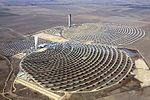
Pollution Industrial ecology · Solid waste treatment · Waste management · Air pollution (control · dispersion modeling) · Water (Wastewater treatment · Agricultural wastewater treatment · Industrial wastewater treatment · Sewage treatment · Water purification)Renewable energy Alternative energy · Energy development · Energy recovery · Energy efficiency · Renewable energy (development) · Sustainable energy · Fuel (Alternative fuel · Biofuel · Hydrogen technologies) · Transportation (Electric vehicle · Hybrid vehicle)Conservation Birth control · Permaculture · Conservation ethic · Recycling · Ecoforestry · Conservation biology · Environmental preservation · Remediation · Green computing · Building (Green · Natural · Sustainable architecture)Categories:- Applied sciences
- Energy policy
- Energy development
- Technology development
Wikimedia Foundation. 2010.



